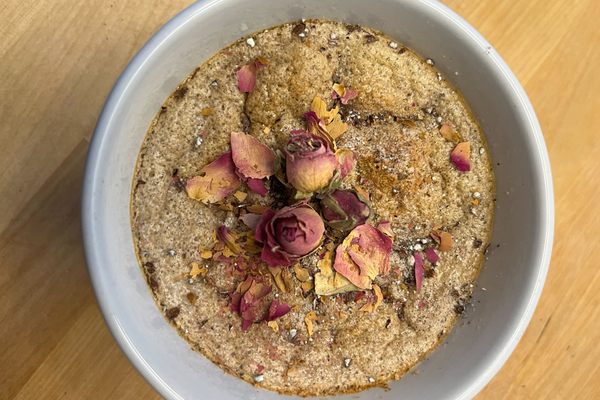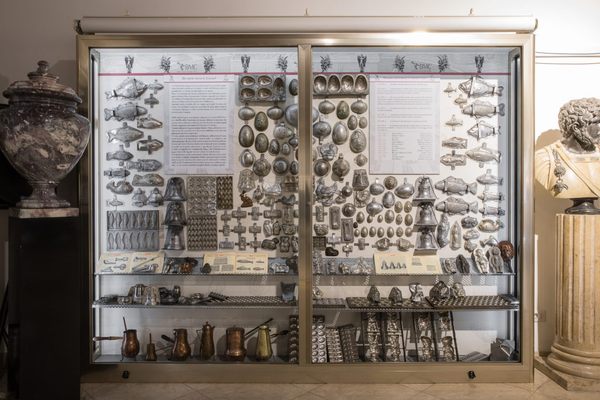Make 19th-Century ‘Neapolitan Pizza’ for Dessert
This “exquisite” recipe comes from the book that created our modern concept of Italian food.
Not long ago, if you ordered Neapolitan pizza at an Italian restaurant, you might have ended up with a slice of custard pie.
The modern definition for pizza did not appear in an Italian dictionary until 1905. The Italian word pizza, which is likely related to Greek pita and Turkish pide, was originally a general term for flat baked dishes made with flour. You can still see this term in action today in dishes like pizza rustica, a rich egg-and-cheese-stuffed pie from central Italy, or pizza Ebraica, a blackened cookie made with nuts and dried fruit that originated in the Jewish quarter of Rome.
View this post on Instagram
Before the 20th century, the cheese pizza that we know and love was a local street food little-known outside of Naples. Some 19th-century writers who encountered cheese pizza even described it with contempt. In 1886, Carlo Collodi, author of Pinocchio, called it “a patchwork of greasy filth that harmonizes perfectly with the appearance of the person selling it.” In 1884, journalist Matilde Serao, who was Neapolitan herself, seemed to squirm as she described how street vendors’ pizza slices “turn yellow in the sun as the flies eat them.”
Pizza was most popular among the lower classes of Naples, which was then Europe’s most densely populated city. But in expressing concern over the hygiene of pizza, both Serao and Collodi mingled their disdain for the food with disdain for the urban poor who primarily ate it. The legend of Italy’s Queen Margherita sampling the pizza Margherita made in her honor, though probably untrue, became popular in part because of what it symbolized: the upper classes showing compassion for the humblest people of the city.

Mass emigration from Naples to countries like the United States in the late 19th century helped spread cheese pizza to the world. In the late 20th century, demand for cheese pizza increased across Italy in part because of an influx of foreign tourists demanding a dish they did not realize was specific to one city.
But long before cheese pizza took the world by storm, there was another, more widely known dish in Italy called “Neapolitan pizza.” This was a baked dessert pie stuffed with almond custard. Other than the name, there’s no relation between the dishes at all.
Bartolomeo Scappi, an influential cookbook author of the Italian Renaissance, included a recipe for the pizza alla Napoletana in his 1570 cookbook, among other kinds of sweet pizza. More than three centuries later, in 1891, Pellegrino Artusi featured the same dish in his own cookbook. La Scienza in cucina, published when Italy had been unified for only 20 years, was the first to bring together recipes from different Italian regions and present them as one national cuisine.

Although Artusi laid the groundwork for the modern concept of “Italian food,” his book skews towards the cuisine of northern Italy. Artusi lived most of his life in Florence and was likely unfamiliar with cheese pizza, which does not appear in his cookbook. However, Artusi does include two other recipes for sweet pizza dishes. Pizza gravida, meaning “pregnant pizza,” is very similar to pizza Napoletana, but with raisins and pine nuts in the filling. Pizza a libretti, which means “booklets pizza” but is sometimes translated as “accordion cake,” is completely different: a rectangular fried pastry with flaky layers that resemble the pages of a book, or the folds of an accordion.
In modern Italy, the phrase pizza a libretto has taken on a different meaning. Today, pizza a libretto refers to a slice of cheese pizza eaten folded over itself like a book, also called pizza al portafoglio, “wallet pizza.”
Don’t try folding a slice of Artusi’s sweet, custardy pizza Napoletana. Enriched with ricotta and egg “reds” (Artusi’s term for yolks), Artusi’s recipe for this “exquisite-tasting dessert” includes regular sweet almonds as well as two or three bitter almonds for an extra-strong flavor. Bitter almonds are still sometimes used in cuisine, but their sale is often heavily regulated or outlawed today. This is because when crushed, unfortunately, they release cyanide. Almond extract is a safer substitute.
Pizza alla Napoletana
Adapted from Scienza in cucina e l’arte di mangiar bene by Pellegrino Artusi (1891)
- Prep time: 140 minutes
- Cook time: 45 minutes
- Total time: 185 minutes
- 1 9-inch pie
Ingredients
- Ingredients for crust:
- 1 ¾ cups flour
- 1 cup white sugar
- 6 ¼ tablespoons butter
- 2 ⅓ tablespoons lard
- 1 egg
- 1 egg yolk
- Ingredients for filling:
- ¼ cup white sugar
- ¾ cup whole milk
- 2 ¾ tablespoons flour
- 1 egg
- 2 egg yolks
- ⅔ cup ricotta
- ½ cup finely ground peeled almonds or almond flour
- ½ teaspoon almond extract
- Zest of half a lemon OR 1 ½ teaspoons vanilla extract
- Powdered sugar (for serving)
Instructions
-
Let the butter and lard soften before mixing together 1 ¾ cups flour, 1 cup sugar, butter, lard, 1 egg, and 1 egg yolk into a smooth dough.
-
Wrap dough in cellophane and chill in the fridge for at least 2 hours, or overnight.
-
In a saucepan, combine milk, ¼ cup sugar, 2 ¾ tablespoons flour, and 1 egg over low heat and mix with a spatula or wooden spoon until thickened. Stir in 1 egg yolk, the almond extract, and the lemon zest or vanilla extract. Remove from the heat, stir in the ricotta and ground almonds, and let cool.
-
Divide the dough into two equal halves. Roll one half out until it’s large enough to cover the bottom of a 9-inch cake pan, with the sides of the crust rising about half an inch around the sides.
-
Spread the filling to the cake pan with a spoon or spatula and smooth it out evenly. Roll out the other half of the pastry crust into a circle, and carefully lay it over the top of the custard filling. Crimp the edges of the two pastry halves together with a fork.
-
Brush the top of the crust with the other egg yolk. Bake for 45 minutes at 325°F until golden brown.
-
Remove from the oven and let the pizza Napoletana cool to room temperature before covering and chilling in the fridge.
- Serve cold, dusted with powdered sugar.
Notes and Tips
Artusi suggests mixing the dough on a flat surface with the back of a knife at first so as not to touch with your hands, so the dough doesn’t “burn,” or become too soft. Make sure the dough is chilled before using, as it will be delicate and more difficult to work with when it’s too hot.
We’ve swapped in almond extract for bitter almond in Artusi’s recipe. Artusi says to blanch the almonds and peel their dark skins before grinding. To save time, you can buy peeled almonds, or use almond flour.
Gastro Obscura covers the world’s most wondrous food and drink.
Sign up for our email, delivered twice a week.


























Follow us on Twitter to get the latest on the world's hidden wonders.
Like us on Facebook to get the latest on the world's hidden wonders.
Follow us on Twitter Like us on Facebook